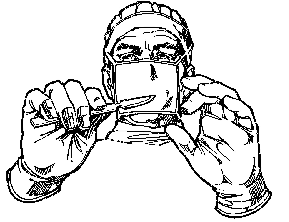Sutures are used for closing wounds in all body tissues and are the most frequently implanted foreign materials. Evidence of suturing wounds dates back to between 5000 and 3000 BC with the invention of eyed needles made of bone.
Early references to suture materials were made in the Caraka Samhita written 3000 years ago and in the Sushruta Samhita 2500 years ago in which the use of plaited horsehair, cotton, leather strips and tree bark fibers was described for closing wounds. Cautery and tendon strip ligatures were used to control bleeding and wounds were closed with acacia thorns and the jaws of ants.
History of Surgical Sutures:
Physicians have used sutures for at least 4,000 years. Archaeological records from ancient Egypt show that Egyptians used linen and animal sinew to close wounds. In ancient India, in the days of Sushrutha physicians used the heads of beetles or ants to effectively staple wounds shut. The live creatures were affixed to the edges of the wound, which they clamped shut with their pincers. Then the physician cut the insects’ bodies off, leaving the jaws in linen strips coated with a resin or with an adhesive mixture of honey and flour appeared in Ancient Egyptian medicine, as forerunners of our modern-day skin closure tapes Cornelius Celsus described small metal clips for closure.
Also read: Planning a surgery in summer?
Galen repaired the severed tendons of gladiators with sutures. Gold wire sutures were introduced by Fabricius in 1550 and silver wire by Marion Sims in 1850. The great English physician Joseph Lister discovered disinfecting techniques in the 1860s, making surgery much safer. Lister soaked catgut suture material in phenol making it sterile, at least on the outside. Lister spent over 10 years experimenting with catgut, to find a material that was supple, strong, sterilizable, and absorbable in the body at an adequate rate. A German surgeon made advances in the processing of catgut early in the twentieth century, leading to a truly sterile material.
Catgut

Catgut is the name applied to a cord of great toughness and tenacity prepared from the intestines of sheep, or occasionally from those of the horse, mule and ass. Those of the cat are not employed, and therefore it is supposed that the word is properly kit gut , kit meaning fiddle, and that the present form has arisen through confusion with kit cat.
Also read: Surgery in Summer
Today, stainless steel wire sutures are used, for example in cardiovascular surgery. Silk sutures gained popularity, along with waxed thread, in the eighteenth century, although catgut was still probably the material most often used.
In the nineteenth century, Joseph Lister stored catgut in a solution of olive oil and carbolic acid, and to improve its handling characteristics he chromicized catgut and found the unexpected additional benefit of delayed suture absorption. Since the mid-twentieth century, technological advances have produced a range of synthetic absorbable and nonabsorbable materials for use as sutures, in braided and monofilament forms.
Both synthetic and natural sutures benefited from advances made in the textile industry which allowed for braiding of suture material and coating of sutures with a variety of agents coupled with the development of suture materials has gone the development of the eyeless atraumatic needle. The metal used in needle manufacture has progressed from carbon steel (often chromicized against rust) to modern stainless steel. The shape of needle tips has been fashioned to suit their intended purpose, for example, triangular tipped (cutting) needles for easy penetration; round-bodied needles for minimal trauma. A wide range of needle sizes and shapes are now available, with needles for microvascular work being barely visible to the naked eye.
Size of sutures:
Standard sizes of sutures (with diameters in inches) follow a pattern set at the beginning of the 1900s by the United States Pharmacopoeia. A metric system is also used but has yet to gain popularity in the United Kingdom. Sutures were originally sized 0 to 3, but as materials advanced and suture thinner than 0 were developed, extra 0s had to be added. Today, the scale starts at 3 for the thickest suture then 2/0, 3/0… up to 12/0, which is the thinnest.
Natural and Synthetic sutures:

Natural sutures are made of catgut or reconstituted collagen, or from cotton, silk, or linen. Synthetic absorbable sutures may be made of polyglycolic acid, a glycolide-lactide copolymer; or polydioxanone, a copolymer of glycolide and trimethylene carbonate. These different polymers are marketed under specific trade names. Synthetic nonabsorbable sutures may be made of polypropylene, polyester, polyethylene terephthalate, polybutylene terephthalate, polyamide, different proprietary nylons, or Goretex. Some sutures are also made of stainless steel.
Suture needles are made of stainless or carbon steel. The needles may be nickel-plated or electroplated. The packaging material includes water-resistant foil, such as aluminum foil, as well as cardboard and plastic.
New sutures are being developed all the time, to better respond to particular surgical needs. While not replacing sutures, scientists have also devised alternative methods of wound closure.
- The first surgical stapler was invented in 1908, but stapler technology developed considerably in the 1990s. Precise machines are able to place absorbable staples, as thin as four human hairs, beneath the top layer of skin to secure an incision with minimal scarring.
- A related device, first tested on patients in the United States in 2000, is a surgical zipper. A surgeon can place the zipper over a straight incision and zip the wound closed, eliminating the need for suturing.
- New surgical closure method that is evolving is surgical glue.
Pic courtesy: skincancercourses.com
